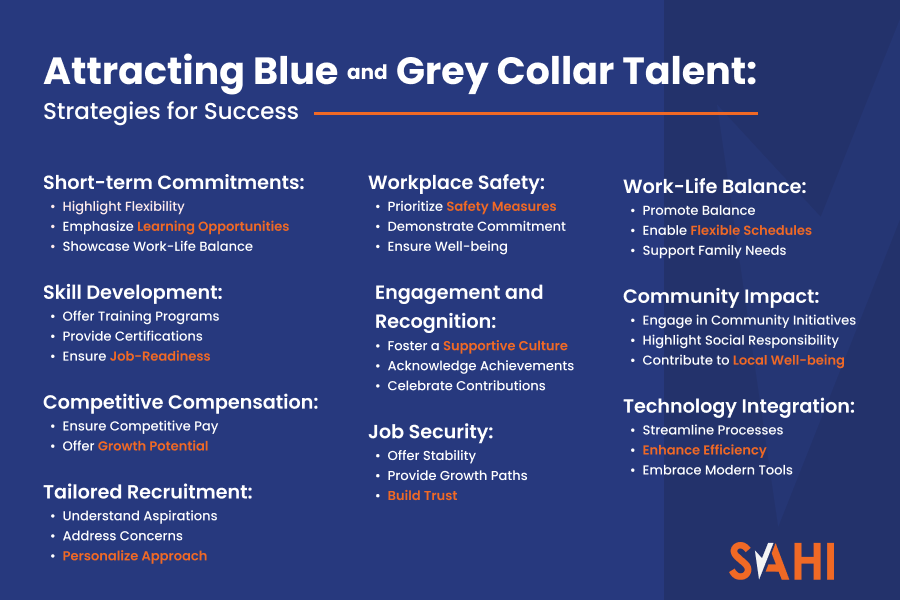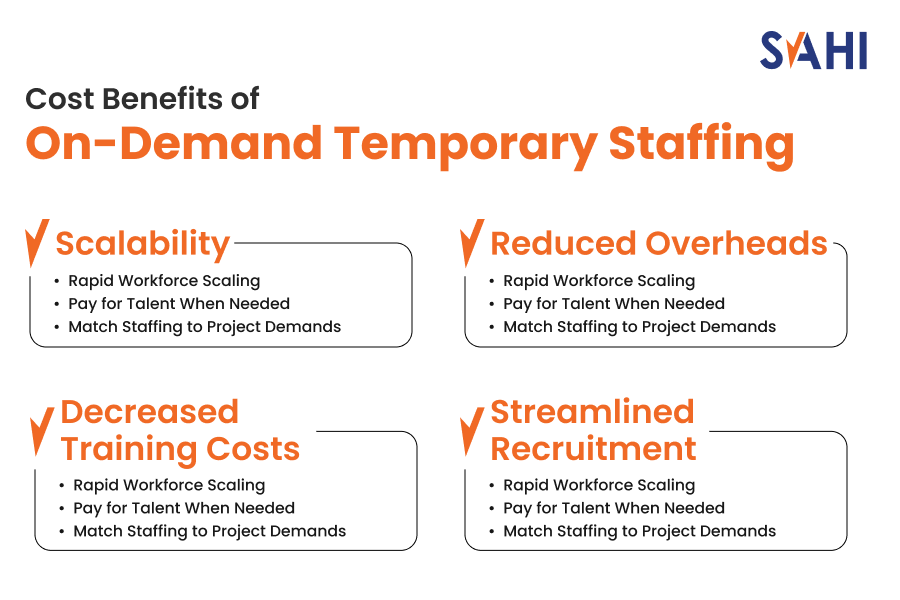The industry is witnessing an undeniable shift, with the dynamics of the workforce undergoing significant transformations.
This change is propelled by numerous factors such as technological advancements, globalised operations, and ever-changing market demands. Central to this transformation is the rise of flexible staffing, on-demand staffing, and contract employment which are offering companies a unique blend of talent agility and operational efficiency.
For HR Managers and Executives, understanding and navigating this dynamic work environment have become quintessential. Blue-collar and grey-collar workers, traditionally the backbone of industries like manufacturing, logistics, and services, are now expressing their needs and aspirations more vocally than ever.
Why Do HR Strategies Need To Change?
As the lines between permanent and contract staffing blur, HR strategies have to accommodate these changing preferences. This evolution emphasises the crucial role of employment agencies and staffing services in offering tailored staffing solutions.
In this environment, the role of HR has transcended from being just a supportive function to a strategic one. They’re not just filling positions; they’re curating a workforce that can adapt, evolve, and drive business objectives.
With the increasing prominence of blue and grey-collar workers in this dynamic work environment, it’s imperative for HR professionals to stay ahead of the curve. Hence, they can align their strategies with innovative staffing solutions that cater to these segments effectively.
Why the Need for Flexible Staffing?
In the rapidly evolving landscape of employment, traditional modes of hiring and workforce management have seen disruption.
With global markets fluctuating, businesses constantly seek ways to remain competitive, and one such strategic advantage is the adoption of flexible staffing. The concept of flexible staffing has garnered immense popularity and significance.
This is due to its ability to offer businesses the agility to adapt to fluctuating workloads, seasonal demands, and unexpected market shifts. Moreover, this model aids businesses in navigating the uncertain terrains of the modern business environment, while playing a pivotal role in cost optimization and resource allocation.
Given its increasing importance, understanding the core of flexible staffing becomes paramount.
What is Flexible Staffing?
Flexible staffing, often associated with terms like temporary staffing, on-demand staffing, or contract employment, refers to an employment arrangement. In such an arrangement, employees are hired based on specific project requirements or for a predetermined period.
Unlike permanent roles, these positions may vary in duration and often do not offer long-term employment guarantees. In today’s dynamic work environment, flexible staffing solutions offered by employment agencies and staffing services have become indispensable.
They provide businesses with the freedom to adjust their workforce based on demand, project requirements, or budget constraints. More so, it equips HR strategies with a tool to ensure that talent is sourced efficiently, without being bound by the constraints of traditional hiring processes.
How is Traditional Staffing different from Flexible Staffing?
Traditional staffing often involves long-term employment with fixed roles, while flexible staffing, such as on-demand or contract employment, adjusts to business needs dynamically. Flexible staffing solutions, provided by modern employment agencies, offer cost-efficiency, agility in talent acquisition, and adaptability to market fluctuations, making them a preferred choice in today’s dynamic work environment.
What is the Role of Flexible Staffing in Talent Development and Retention?
In the intricate dance of talent management, the role of flexible staffing has taken centre stage. Particularly when considering the blue and grey-collar segments, the tailored strategies provided by flexible staffing models can be instrumental in both attracting and retaining the right talent.

How to attract Blue and Grey Collar Talent
To target the specific needs of the blue and grey-collar workforce demographic, employment agencies and staffing services have begun to employ strategies that resonate with their unique aspirations and concerns. Some of these strategies include:
Short-term Commitments
Recognizing that many in these sectors value short-term roles for the flexibility they offer, on-demand staffing positions can be promoted as opportunities for learning without long-term commitment.
Skill Development
Offering training programs and certifications. This not only adds value to their professional journey but also ensures they are job-ready from day one.
Competitive Compensation
While blue and grey-collar roles might be temporary, ensuring competitive pay and benefits can make these roles attractive.
How to Retain Talent and keep Employees Engaged?
Once the talent is onboarded, the next hurdle is retention. With the high turnover rates prevalent in blue and grey-collar jobs, it’s imperative for HR strategies to focus on keeping these employees engaged.
The benefits of on-demand staffing play a pivotal role here:
Flexible Schedules
One of the primary advantages of flexible staffing solutions is the ability to offer varied schedules, ensuring work-life balance which can greatly enhance job satisfaction.
Diverse Opportunities
On-demand staffing can provide workers with the chance to work across different projects or industries, preventing monotony and promoting continuous learning.
Performance Incentives
To encourage quality work and loyalty, businesses can introduce performance-based incentives, a strategy that resonates deeply with the blue and grey-collar segments.
Feedback Mechanism
Regular feedback and open communication channels can make employees feel valued and heard. This simple strategy can significantly reduce turnover rates
How To Optimise Workforce Costs Through Flexible Staffing?
In an era where fiscal prudence is not just preferable but paramount, businesses worldwide are seeking innovative means to manage their operational expenses.
Flexible staffing, particularly on-demand temporary staffing and contract employment, has emerged as a cardinal strategy to achieve this. By adopting flexible staffing solutions, companies can realise both immediate and long-term financial benefits.

What are the Cost Benefits of On-Demand Temporary Staffing?
The immediate financial benefits of on-demand staffing solutions are multifaceted:
Scalability
Businesses can quickly scale their workforce up or down based on project requirements or market demands, ensuring they pay for talent only when needed.
Reduced Overheads
Temporary staff often come without the additional costs of benefits, insurance, and other perks associated with full-time employees, resulting in significant cost savings.
Streamlined Recruitment
Employment agencies specialising in on-demand staffing can reduce the time and resources a company might spend on the recruitment process.
Decreased Training Costs
Many staffing solutions ensure that temporary staff are trained and job-ready, minimising the costs related to onboarding and training.
What are the Long-Term Financial Impacts?
While the immediate benefits of contract employment are evident, it’s the long-term impacts that often solidify its value:
Reduced Turnover Costs
By employing talent on a project basis, businesses can mitigate the financial implications of high turnover rates typical in some industries.
Adapting to Market Volatility
In fluctuating markets, having a flexible workforce allows businesses to adjust without the burden of significant layoffs or hiring sprees, leading to consistent savings
Infrastructure Savings
A flexible staffing model, especially when coupled with remote work opportunities, can reduce the need for expansive office spaces and associated costs.
Strategic Financial Planning
Knowing that workforce costs can be adjusted based on business needs allows for more strategic financial planning, ensuring resources are allocated efficiently.
How to Navigate Compliance and Risk Management in a Dynamic Work Environment?
As businesses evolve and adapt to the fluid nature of today’s markets, the realm of compliance and risk management grows increasingly intricate.
This is particularly true when incorporating flexible staffing solutions such as contract employment. Addressing regulatory challenges and ensuring a productive, safe workforce has become a cornerstone for HR strategies in this dynamic work environment.
What are the Regulatory Challenges in Contract Employment?
Contract employment, while immensely beneficial, comes with its own set of legal challenges:
Employee Classification
Misclassifying employees as contractors can lead to legal repercussions. Ensuring a clear distinction in roles and responsibilities can mitigate such risks.
Benefits and Rights
In some jurisdictions, temporary or contract workers may still be entitled to certain benefits. Being abreast with local labour laws ensures businesses stay compliant.
Contractual Agreements
Clearly defined contracts that lay out terms of employment, compensation, and job duration can preempt many potential legal disputes.
Tax Implications
Contract employees might have different tax stipulations. Collaborating with staffing services and tax experts can help navigate these waters seamlessly.
How to ensure Workforce Efficiency and Safety?
Maintaining efficiency and safety in a workforce that’s constantly in flux can be challenging but crucial:
Regular Training
Even if workers are on short-term contracts, providing them with consistent training ensures they remain productive and aware of safety protocols.
Performance Monitoring
Using tools and software to monitor and evaluate the performance of temporary staff can ensure they align with company standards.
Health and Safety Protocols
Clear guidelines, especially for blue-collar jobs, can prevent workplace accidents and ensure the wellbeing of the workforce.
Open Communication Channels
Encouraging contract workers to voice concerns or provide feedback can lead to an environment where issues are addressed promptly, ensuring efficiency and safety.
What are the Long-Term Benefits of Adapting to Change?
The future is anything but predictable, especially in the realm of workforce management.
As businesses pivot and reinvent themselves in response to an ever-changing landscape, the rewards of flexibility and adaptability become more apparent. Embracing change not only fortifies an organisation’s present but also paves the way for a prosperous future.
Why Building Resilience in Blue and Grey Collar Workforces Is Important?
In today’s dynamic work environment, resilience is no longer a luxury but a necessity.
Blue and grey-collar workers, often at the frontline of operational shifts, need to be equipped with the skills and mindset to handle change effectively:
Flexible Skill Sets
Training workers to be multifunctional ensures they can easily adapt to varying roles and tasks as business needs change.
Mental Agility
Promoting a culture that values adaptability helps workers approach challenges with a problem-solving mindset, turning potential disruptions into growth opportunities.
Employee Well-being
Prioritising the mental and emotional health of workers ensures they have the resilience to navigate the highs and lows of a fluctuating market.
How to align HR Strategies with Workforce Trends?
As businesses reshape their HR strategies, aligning with SAHI’s vision becomes paramount:
Tailored Workforce Solutions
Innovative workforce solutions ensure that recruitment, training, and retention methods are optimised for the unique needs of blue and grey-collar workers.
Sustainable Talent Management
In line with focus on talent sustainability, HR professionals can integrate programs that prioritise long-term growth and development of workers, regardless of their contract duration.
Cost-Efficient Practices
By aligning HR practices with cost optimization, businesses can ensure they get the maximum ROI on their staffing investments.
How to Prepare for Future Workforce Trends?
The only constant is change, and HR professionals who can anticipate and prepare for shifts in the labour market will be a step ahead:
Continuous Learning
Encouraging a culture of ongoing education ensures that the workforce is always equipped with the latest skills and knowledge.
Data-Driven Decisions
Leveraging analytics and AI can help HR professionals forecast workforce trends and make informed decisions.
Flexibility as a Norm
Recognizing that the traditional 9-5 work paradigm is evolving, integrating more flexible staffing models now can prepare businesses for the workforce of tomorrow.
Conclusion
In the labyrinth of today’s workforce dynamics, one thing is abundantly clear: stagnation is not an option.
Blue-collar and grey-collar sectors, intrinsic to the foundational pillars of many industries, have found themselves at the epicentre of transformative changes. Amidst these shifts, the role of flexible staffing has never been more pertinent.
Flexible staffing solutions, from on-demand temporary staffing to contract employment, serve as pivotal tools in navigating these waters. They not only cater to the immediate requirements of businesses but set a trajectory for long-term adaptability and success.
For blue and grey-collar workers, these models offer the dual advantage of job security and diversity of experience, making them indispensable assets in the eyes of their employers.
HR Managers and Executives stand at the helm of these transformative changes. Their strategies, choices, and visions have ripple effects that permeate through the entire organisation.
Aligning these strategies with innovative solutions, much like those championed by SAHI, is no longer just a competitive advantage—it’s a necessity. SAHI’s commitment to tailoring workforce management, optimising costs, and ensuring talent sustainability provides a beacon of direction for these HR professionals.
In closing, as the tapestry of the workforce continues to evolve, it’s not just about riding the wave but steering its direction. HR professionals, with the power of flexible staffing solutions and the visionary ideals of entities like SAHI.
Hence, they are perfectly poised to lead their organisations into a future replete with growth, adaptability, and excellence.


